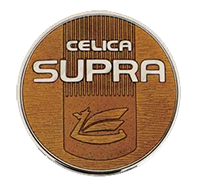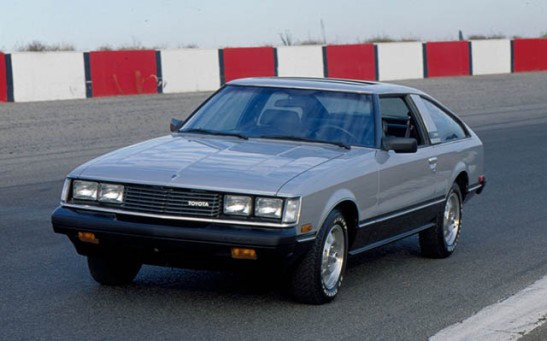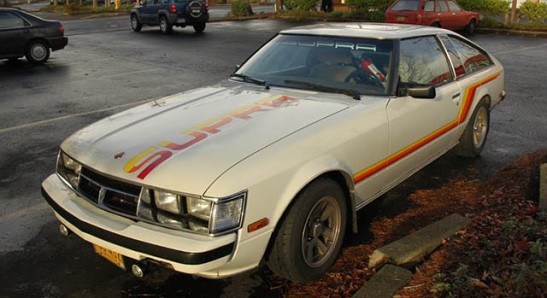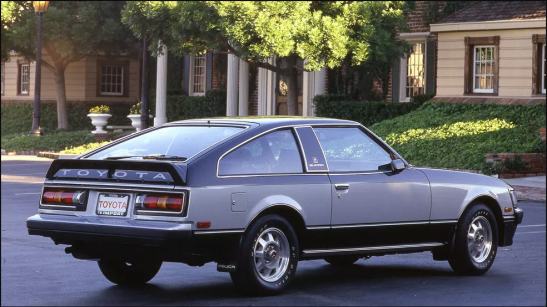1978 – 1981 Toyota Celica: The Americanized Japanese GT

1980 Toyota Celica GT
News, rumors or whatever passes for it, suggests that Toyota might bring back the Celica. If so, there is speculation that it could be the next generation Toyota FR86. The Celica created a sensation when it was introduced back in 1974. As Japan’s first mass produced sports car in America, many were calling it the Japanese Mustang. The first generation car was still selling well when Toyota revamped it for the 1978 model year.
The second gen car sometimes referred to as A40/A50, was designed by Caulty Design Research Studios (CALTY), a Toyota subsidiary that was spooling up to be Toyota’s American focused car designer. The ’78 Celica was also designed with Europe in mind but mechanically it was strictly Japanese. Like before, it was offered in popular liftback and coupe body styles with rear wheel drive. No longer looking like a miniaturized American pony car, the Celica had grown slightly wider and a few inches longer, although it rode on the same 98.4 inch wheelbase.

1979 Toyota Celica GT
It’s lines were softened, resembling a stretched Chevy Monza more than any Mustang. More prominent this time was a thick “B” pillar, a design trait that would be further emphasized in future Celica. Right out the gate, it impressed the American public and motoring press with Motor Trend naming it it’s Import Car of the Year for 1978. Much of that praise came from the Celica’s smart blend of packaging, comfort and value. This was a time when Toyota’s catchy “Oh What a Feeling” ad campaign was promoting Toyota’s increasing popular car lineup in America.

Dash layout from 1979 brochure
In keeping with the Japanese practice of creating maximum interior space, the Celica got new more comfortable seats, revised dash and control layouts. This generation of the Celica is interesting because it’s perhaps the last Celica to look good in brown (not unlike many late ’70 and early ‘80s cars). It also was the last of the soft looking cars. As the design progressed, the Celica’s appearance grew more angular and aggressive looking. The A40 in particular with the quad round headlight treatment looked almost homely as a coupe.

1978 Toyota Celica ST
While there were 5 engine configurations globally and no less than 14 versions each configuration with over 70 in Japan. American buyers were presented with just two trim levels; the ST and GT (this despite being the largest market for the Celica). Only the GT could be had as a coupe and liftback, leaving the lone ST with the statelier coupe profile. Both were fitted with a 2.2-liter SOHC four cylinder engine that produced an adequate 95 hp. You could even order your Celica with a 5 speed manual this was at a time when many domestic “sporty” cars still were using four speed transmissions.
The GT featured things like low profile tires with chrome rings added to the rims. The GT not only handled better, it was posh – often loaded with air conditioning, heated rear windows and sunroofs. Some cars were fitted with impressive cassette stereos with 5 band graphic equalizers. All cars got radial tires, a rear stabilizer bar and disc brakes all around. Despite the Celica’s more ambitious engineering agenda, American bound cars never got the fully independent suspension that eventually arrived on top Japanese models.

1979 Toyota Celica GT with aftermarket wheels
The Celica’s 2.2-liter four cylinder engine was new in 1975 and updated over the years, but was never considered a truly high performance engine. By 1979, dealers were getting a version of the Celica that was being called Celica XX in Japan. It would later be sub-branded as a Supra and was the highest trim of the Celica GT. By the time the “Celica

New Supra badge
Supra” arrived for the American market, it was sporting a V6 engine. Based on a version of the JDM 4M-E, the small by American standards 2.6-liter inline six could be matched to a four-speed automatic or five-speed manual transmission. With 110 hp at 48000 rpm, the new electronically fuel injected engine (EFI) was considered lazy for truly aggressive motoring but was well suited for highway cruising and was fairly efficient. Starting with the 1980 model year, the front end of all Celica had moved from round headlights (A40) to a square ones (A50).

By 1980 Toyota would stress it’s racing efforts more in Celica promotions
Sales peaked early, at an all-time high (close to 200,000 units) and remained in six-digit territory despite trailing off until 1982 when the third gen car was introduced. Minor changes occurred, mostly to lights, bumpers and wheel choices. Body styles remained coupe and liftback with only the occasional third party variant like the Griffith

1981 Celica Sunchaser
Sunchaser for 1981. Its targa top design offered the closest thing to a Celica convertible. Unfortunately, the Sunchaser came too late as the next year Toyota would launch a factory blessed convertible. There were other rare Celica, like a TRD turbo that capitalized on the Celica’s rising profile as both a race and pacecar. I remember having a diecast toy based on the TRD turbo from Tommica in the early ’80s.

1981 TRD Celica Supra Turbo
The final Celica Supra of this generation would get the familiar silver and black color scheme that would be associated with the next generation’s Supra. For the 1981 model year, both trims got new engines for American bound ST and Celica Supras. The Supra’s 2.8-liter got a revised transmission and final drive ratios. Power was up only slightly to 116 hp. This engine would be short lived, as it would be replaced with the rest of the car for the 1982 model year. The ST got a revision to it’s four-cylinder – now with 96 hp and drive ratios that favored the 3-speed automatic transmission.
Despite being enormously popular (especially on the West coast), very few Celicas of this era survive. You’re likely to find more of the highly praised first gen car than the second, despite its modest sales by comparison. That may be why these cars are nearly forgotten. Its likely that few today younger are even aware that Celica’s were once rear wheel drive – like the Supra is now. That’s sad considering that the A50 was the staging ground for the Celica to go from attractive mini ponycar to formidable grand tourer and eventually legendary sports car as the Supra.

1981 Toyota Celica Supra

I really enjoyed this post—I agree that it is surprising that so few of these second-generation Celicas remain. There is interest in these cars—my post on the 1981 Celica has the most hits of any Japanese car I have covered: